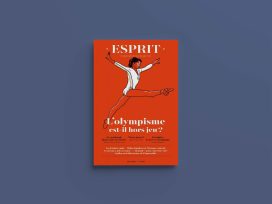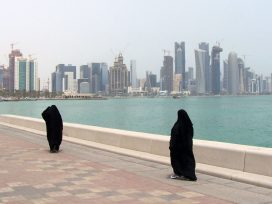“Football’s a man-made game. You keep score with numbers. But in this, there’s no field, no rules, no opponent. Just you and the wave. […] I’ve watched you once or twice. You surf like it’s some kind of street fight. You jerk along from moment to moment, fighting everything that comes at you. Always trying to win. […] The only way to win out here is to surrender.”
Bodhi, addressing Utah, in Point Break (1991)
The key scene in Point Break (1991) is situated in the breaking waves outside Los Angeles. Bodhi (Patrick Swayze) has just persuaded Utah (Keanu Reeves) to join a nocturnal surf session. At this very point in the film, Utah’s transformation begins: from stiff and competitive control freak – the standard American football jock – to stoic surfer. It is also at this point that the profound deepness of Bodhi’s being is revealed. Bodhi, “a searcher”, seeking not only the ultimate adrenaline rush, but also his own spirtual essence. “Bodhisattva”, as he is also called, hates violence and sees surfing as a “state of mind” – “a place to lose yourself and find yourself” – based on respect for the ocean. According to this “modern savage”, everything moves in circles, and therefore he chooses to live his life according to the cycles of nature, and not according to the limits of the Law.
FBI agent Utah, assigned to the task of policing Bodhi’s transgressions, seems increasingly discontent with being the defender of the Law. His metamorphosis from footballer to surfer is prompted by an urge to submit to nature – his own drives included – in the same way that Bodhi does. Nevertheless, Utah never becomes quite that radical. Swayze’s surfing Buddha ejects himself from his worldly being, by allowing himself to be swallowed by a monster wave, thus fleeing the Law. Utah, on the other hand, may surf every day, but remains in our world, obeying our laws.
The final scene is hardly unpredictable: we already know that drowning, as well as other worldly things, leaves Bodhi unperturbed: “It is not tragic to die doing something you love.” Bodhi is, quite simply, not of this world. As Utah’s colleague has always said about the surfers: “Forget about it kid – they’re ghosts!”
Is it the Bodhi cliché that leads movie buff Slavoj Zizek to note “the ultimate irony” that for Gilles Deleuze – “the ideologist of late capitalism” – “the sport was surfing, a Californian sport par excellence if there ever was one”? The surfing-sustained sublimation of Utah is exemplary in comparison with Bodhi, who stands for everything that Zizek turns against in his ideology critique. Does not the violence-hating Bodhi preach precisely the type of westernised pop Buddhism that has become “the perfect ideological supplement to virtual capitalism”? Does not the surfing Buddha emphasise those aspects of surfing – liberation from (self-)discipline, absence of rules and objectives negotiated by human subjects – that chime with “the postmodern superego” that signifies late capitalism? Surf! Enjoy!
Zizek’s spectacular critique of “deleuzianism” is almost as much of a crowdpleaser as Point Break. However, Peter Hallward’s more subdued mediation on Deleuze raises issues that are just as important. The title of Hallward’s publication – Out of this World – hints that his critique also touches on the theme of spiritualism. Does not Deleuze’s philosophy of creation emphasise the extra-worldly? Does it not state that the “actual” world is determined by “the virtual”? If the answer to these two questions is yes, then Deleuze’s philosophy leaves little space for the human as an acting subject. His thought may be spiritually rewarding – our extra-worldly Bodhi would surely have liked it – but “those of us who still seek to change our world and to empower its inhabitants will need to look for our inspiration elsewhere”.
There are however other ways of understanding Deleuze and his relation to politics, as well as surfing. If, instead, we construe the surfer simply as one body among other bodies, entirely freed from mysticism and transcendence, we are neither led out of this world (Hallward), nor towards empty enjoyment (Zizek). To surf is to manouver the intensive, deploying the tactical slogan: pursue difference; produce difference!
Sympathy for the ocean
Bodhi: “You have to feel what the wave is doing, accept it’s energy, get in sync. Just feel it all moving in the blackness … you don’t need to see.”
Utah: “Yeah, vision is highly overrated.”
What exactly did Deleuze say about surfing? In a 1985 interview, he comments upon a shift in how sports are conducted: “The kind of movements you find in sports and habits are changing. We got by for a long time with an energetic conception of motion, where there’s a point of contact, or we are the source of movement. Running, putting the shot, and so on: effort, resistance, with a starting point, a lever. But nowadays we see movement defined less and less in relation to a point of leverage. All the new sports – surfing, windsurfing, hang-gliding – take the form of entering into an existing wave. There’s no longer an origin as starting point, but a sort of putting-into-orbit. The key thing is how to get taken up in the motion of a big wave, a column of rising air, to ‘get into something’ instead of being the origin of an effort.”
Deleuze goes on to constrast these new habits of sport with the old habits of thought still prevalent in contemporary philosophy. Rather than creating concepts in relation to movement and becoming, philosophy still reflects upon that which is supposedly eternal and fixed. The surfing reference is thus not – as one would think when reading Zizek – framed in an ethics of enjoyment, but in a discussion on how the nature of thought is construed. It is thus deployed in the critique of “the dogmatic image of thought” that signifies mainstream philosophy – a theme that features throughout Deleuze’s entire production.
We will later discuss What is Philosophy?, which also refers to surfing in relation to the image of thought. Nevertheless, let us first continue examining the 1985 interview, in which the reference to surfing leads onto a discussion of Bergson’s philosophy of movement. Deleuze’s interpretation of surfing resonates with Bergson, who describes his “intuitive method” in the following way: “Analysis operates always on the immobile, whilst intuition places itself in mobility or what comes to the same thing, in duration. There lies the very distinct line of demarcation between intuition and analysis.” Does this mean that the “new sports” can be understood as playful means of applying the method of intuition? If so, what does this method consist of?
In Bergson’s thought, “the immobile” denotes matter; the actual world of things perceived and understood by humans. “The mobile”, on the other hand, denotes duration; the “virtual” processes that Bergson calls “the true evolution, the radical becoming” that escapes us. The human mind is thus cursed with an inability to think the mobile in an analytic manner: “In other words, it is clear that fixed concepts may be extracted by our thought from mobile reality; but there are no means of reconstructing the mobility of the real with fixed concepts. Dogmatism, however, in so far as it has been a builder of systems, has always attempted this reconstruction.”
This inability stems from an “optical illusion” generated from ideosyncracies in our systems of perception and cognition. Vision is highly overrated: A human subject only sees “what is already made, and only feels confusedly the making. Thus, we pluck out of duration those moments that interest us, and that we have gathered along its course.” We never see the virtuality of becoming, we only see its effects – the fluid motion of duration can only be perceived and understood as a series of “still images”. Bergson compares to gazing into a kaleidoscope: though it rotates according to a fluid, continual motion, we only perceive a series of distinct patterns. This impaired ability of ours causes us to think in terms of stills, not motions: “The cinematographical character of our knowledge of things is due to the kaleidoscopic character of our adaptation to them.”
The virtual aspects of reality, “the radical becoming”, thus escapes analytic description. We can, however, sense this virtuality in those brief instances when we are connected to our non-conscious, virtual aspects of ourselves – to our own duration. This, then, is the meaning of intuition. In Deleuze’s words: “Intuition is not duration itself. Intuition is rather the movement by which we emerge from our own duration, by which we make use of our own duration to affirm and immediately to recognise the existance of other durations, above or below us.”
Bodhi’s environment – the waves, the ocean – are useful for understanding Bergson’s ideas about intuition and duration. In his preface to Bergson’s An Introduction to Metaphysics, Asbjörn Aarnes suggests that the sensation of the duration can “break through” when one is immersed in an “undulating sea”. The “wandering of the ocean” is construed as a process in which waves – the extensive, measureable matter – are actualisations of “the ocean’s walk, with winds and currents, flood and ebb”.
Acquiring what Bergson calls “sympathy” for the virtuality of the ocean, through the sensation of one’s own virtuality – does this not sound like Bodhi’s spiritual mumbo-jumbo about “respect for the ocean” and surfing as “a state of mind”? Yes and no. Bergson was keen to emphasise: “there is nothing mysterious” about intuition. If one accepts the notion of duration – the notion of a virtual aspect of reality – intuition is simply the “rigorous” and “precise” method with which one explores this reality. We can take this demystification one step further: Manuel DeLanda has taught us that there are natural scientific theories that speculate upon the “mechanisms of immanence” that cause the virtual to generate actual things. “There is […] an empiricism of the virtual, even if it does not (and should not) resemble the empirical study of the actual”.
This virtual aspect of reality does not predetermine the actual – at least not to the extent that Hallward purports. As we shall see, the virtual and the actual are engaged in a complex interplay, subject to “mediation” by so-called “intensive processes”. Via these processes, human subjects – surfers, for example – can intervene in the world. Thus, in order to demystify the intuitive capacities of the surfer, we must first examine the notion of intensive processes.
Manouvering the intensive
Utah addressing Bodhi: “I knew you wouldn’t miss the fifty-year storm.”
The undulating sea that Aarnes uses to discuss Bergson’s duration also lends itself well to the explication of the mechanisms of immanence. The waves that Bodhi surfs result from the sun shining on the earth, generating differences in temperature in the atmosphere and in the oceans. This sets air and water in motion. In other words, the waves are created by the pressure that maintains the flow of matter-energy – and thus life – on earth.
When studying these weather systems in detail, one will see that the air – as it rises from the heated surface of the earth – follows particular patterns of motion. The same phenomenon is noticable when we boil water in a pot: at a low temperature on the stove, the difference in temperature evens out through a simple, uniform dispersion of heat, according to a process called conduction. If the temperature is increased, bubbles of hot water break free from colder water. These bubbles accelerate upwards, towards the surface of the water, and then turn back again, according to a circular motion. This phenomenon, convection, is broken if the temperature is increased further. A system of nested vortexes and eddies – turbulence – increasingly starts to usurp and break the order of circulating water.
The capacity to “fall into” these three patterns of motion thus exists immanently in the fluid medium. Various differences in temperature generate different velocities, and at certain distinct limits, the medium switches from one pattern to another – it bifurcates – from conduction to convection, from convection to turbulence. These flows may look more or less chaotic when observed in a pot or in a weather system, but mathematical modelling of the floating medium’s accelerations and decelerations reveal that they follow a strict pattern. Thus, the phenomenon of convection, represented as a graph in a three-dimensional space, has butterfly-like shape – the Lorenz attractor. Turbulence, represented in the same mathematical fashion, has the form of a torus (the shape of a donut).
We never actually see these butterflies and donuts – we can only see the actual whirls and flows that they give rise to. The graphs can thus be understood as representations of the virtuality of systems like heated-water-in-pot or heated-air-in-the-atmosphere. Bergson and Deleuze both refer to Riemann’s concept of multiplicity: a mathematically derived space that encompasses a nested set of graphs, each representing a particular motion pattern at various states (in this case differences in temperature). “Bifurcations”, then, are the instances when one pattern of movement, represented by one graph, shifts to another pattern, represented by another graph.
It may be tempting to see these immanent patterns of movement as a determining force. Indeed, the fact that Bodhi is surrounded by an aura of outerwordliness, and seems determined by the laws of nature, could lead us towards the same conclusion. However, we only need to scratch the surface of Bodhi’s supposed transcendence – and start to view him as an artisan, not an Artist – to rectify this misunderstanding.
When surfing, Bodhi is not connected to something outerworldly; he is merely deploying his craftsmanlike capability to tap the “intensive properties” displayed by various forms of matter. He has simply developed exceptional skills in reading weather map representations of air pressure and temperatures, thus predicting the formation of storms and swell. He knows exactly – at every given speed, at every given position on the wave – how hard to pressurise his board to avoid or assist the onset of turbulence around its fins. Thus, Bodhi’s reality does not only consist of actual waves and virtual phenomena such as convection and turbulence. When practising his craft, Bodhi orientates himself in relation to a specific aspect of reality: differences in atmospheric pressure and temperature, differences in pressure around the board’s fins, and other differences in intensity.
Windsurfing is also an activity based on manouvering differences in intensity. The flow of wind around the rig generates differences in pressure, forcing the board onto “the plane”, at which point it slides freely against the surface of the water. This is a highly non-linear hydrodynamic phenomenon: the board passes a treshold of resistance, causing the board-rig-sailor ensemble to move from one state to another – causing it to, again, bifurcate. Since the Eighties, windsurfing has been about being on this plane. This holds particularly true for the “new school” of freestyle manouvres, such as “the Swayze” (fittingly named after Bodhi’s incarnator). This manouvre is a sequence of motions that manipulate the intensive and virtual aspects of reality: the pressure difference around the rig is neutralised, then intensified; the water flow around the fin shifts from laminar to turbulent, and back again. These phenomena are released in a particular order, according to a particular timing, causing the ensemble to fly, and then slide, through a 360-degree spin.
In other words: the artisanship of surfing consists of experimenting with the workings of the virtual, situated in the actual conditions at hand, drawing upon intensive processes.
The surfer, then, has three aspects of reality to relate to: the actual (the wave, represented by a certain wave height), the virtual (the phenomena of convection and turbulence, represented by the graphs mentioned), and the intensive (the temperature and pressure in the pot or the atmosphere, the pressure in the water around the fins or the air around the rig). Intensities have a particular relation to the “extensive” properties of the actual world: the water in the wave can be measured both in terms of extensive properties (wave height in metres) and intensive properties (pressure in Pascal). If the wave is split in two, the wave height (the extensive) may change, but the pressure (the intensive) stays the same. This might lead us to falsely conclude that the relation between the extensive and the intensive is congruent with the relation between quantitative and qualitative properties. It is therefore important to further specify the concept of intensity: differences in intensities (though not in qualities) has the capacity to drive fluxes of matter or energy.
Bodhi’s sensibility to differences in intensity is not unique to surfers. Life itself is differences in intensity. Our understanding of humanity, culture and society must relate to how the “pressure” of the sun is transformed into activity, such as art or war. When discussing the actual and the virtual, we must always remember that the perennial becoming of the world is driven by intensive processes: “Everything which happens and everything which appears is correlated with orders of differences: differences of level, temperature, pressure, tension, potential, difference of intensity.” In comparison with actual entities, intensive processes may be unruly and somewhat more difficult to detect. Nevertheless, they are tangible aspects of our world, and subject to intervention. This is why Deleuze’s ontology does not lead us out of this world. On the contrary, this ontology can be steered towards an understanding of practical freedoms of agency available to human subjects – including the possibilities for political action. The question is, then, what is the subject? Who or what is doing the manoeuvring?
What is a board capable of?
Member of the surfer gang, during skydiving: “Cheap sex with the cosmos!”
When Zizek comments upon Deleuze’s references to surfing, he does so in the context of a discussion on hardcore pornography, in relation to the contemporary “postsexual eroticism”, signified by depersonalised and degenitalised pleasure. Deleuze’s philosophy emerges as a general affirmation of “multiplicity of intensities, of places of enjoyment”, especially after his thought was contaminated with that of Guattari. This critique is telling. While Zizek has got psychoanalytic reasons for steering the discussion back towards sexual relations among humans, Deleuze and Guattari started their collaboration on affects, in order to develop a more generic, non-anthropocentric understanding of desire: “sexuality can only be thought of as one flux among others” in the desiring production. One way of approaching their point is to examine the emergence of surfing’s bastard children.
Fifty or so years ago, surfers started to experiment with the capacities of the surfboard. What new substances can I slide over; what can my board do then? Along the beaches of Los Angeles (again: “a Californian sport par excellence”) two new assemblages emerged: someone attached a set of wheels to a surfboard, a decade later someone joined a board with a rig. Two new lineages emerged – on for surfing the streets, another for surfing the wind.
New assemblages of bodies – human as well as non-human – thus release new capacities. DeLanda describes this phenomenon as the “enlarged sense” of the intensive: “a process is intensive if it relates difference to difference”. Any given body is thus not only subject to the spatio-temporal dynamisms described by thermodynamics. It is also subject to shifting capacities to affect and be affected, which are released through assemblages. These are always relational – the capability to surf the streets resides neither in the board nor the wheels, but in the assemblage as such. The skateboard, then, is an assemblage that hosts emergent properties: its properties are more than the sum of the properties of its parts. As such, these components are connected through “relations of exteriority” – there is no essence in the separate parts.
Deleuze and Guattari thus write, echoing Spinoza: “We know nothing about a body until we know what it can do, in other words, what its affects are, how they can or cannot enter into composition with other affects, with the affects of another body.” The person who attached a set of wheels onto his or her surfboard initially knew nothing about the body that had emerged. During the 1980s, American skating pioneers experimented with this assemblage: Rodney Mullen examined what the skater-board assemblage is capable of, and Natas Kaupas explored how this assemblage, in turn, can enter affective compositions with walls, kerbs, and handrails. These processes are to be understood in terms of experimentation, rather than pleasure. Or, alternatively, one could argue that the distinction between enjoyment and experimentation is transcended: Natas Kaupas experiments in the surfing of the built environment produced new desires. Experimenting with the capabilities of the world amounts to the same thing as making love to it.
As mentioned above, surfing and the image of thought is also touched upon in What is Philosophy? In relation to the discussion on “conceptual personae” (such as Nietzsche’s Dionysos or Zarathustra), Deleuze and Guattari call for a “a thought that ‘slides’ with new substances of being, with wave or snow, and turn the thinker into a sort of surfer as conceptual persona”. Thought is not a matter of systematising the recognition of the already known – it is to produce concepts, through encounters with the new and unknown. In Difference and Repetition, Deleuze likens thought to an apprenticeship, and to the process of learning to swim – being forced to coordinate one’s body with other modi.
From this perspective, our stumbling processes of thought are always forced upon us by the surrounding world, and it is by virtue of the fact that our bodies are connected to other bodies that thoughts emerge. Only through affective connections among bodies can we aim towards an adequate understanding of the world. Fredrika Spindler writes: “The affects, the external determination” is not “a corrupting impediment to the development of the soul”, but rather “a multifaceted richness, subject to exploration and development”. Again, the Spinozist thematic: what is a body capable of?
The conception of the body referred to by Spindler – affects being seen as a corrupting impediment to the development of the soul – is central to the dogmatic image of thought. This, according to Deleuze, is based on the presumtion that “thought is a natural capacity with an inbuilt affinity with the true.” This capacity can be released in those instances when we sever the ties to our own bodies, as well as the bodies that surround us. Pure thought only emerges when we are shut out from the world of things – like Descartes avoiding the German chill in a warm, separate chamber. For Zizek, the subject emerges in that void: retreating from the world of things enables us to put words to objects. (Is Zizek’s home cinema not the contemporary equivalent of Descartes’ warm and separate chamber? Is the ultimate irony not that Zizek may have accepted Deleuze’s conception of desire had he only got out into nature a bit more often?)
The notion of affects seems particularly useful when discussing relations to external bodies. Nevertheless, the cartesian cogito is more difficult to do away with when we shift our attention inwards, towards the human subject. After all, when learning the “Swayze”, one initially reflects, not standing on the board, upon the sequence of manouvres that trigger the 360-degree spin. In a skateboarding movie, Rodney Mullen describes how he learns new, seemingly impossible tricks: he first reflects upon each sub-element – a flip or other move that he already nails – and then stacks this sequence of elements onto each other, so as to create a unified bloc. Here, Mullen deflates the myth about himself as a transcendent skating-God, projecting an image of himself as a rationalistic engineer. Indeed, in one clip, one can see him reading Descartes.
This cogito is, however, abandoned as Mullen continues his description of how he learns: the bloc is moved to Mullen’s non-conscious motor memory – he speaks of how he runs on “autopilot”. The trick is actualised through teasing out this virtual, non-conscious automatism, during which Mullen focuses on simple percepts – where he locks his vision, how his back shoulder feels in relation to the rest of the body. In short, Mullen relies on something akin to intuition, thus circumventing the sluggish consciousness that can only supply him with kaleidoscopic impressions. Here, Mullen comes across as a thinker of affects, such as Brian Massumi. complicated manoeuvres can only be performed if we manage to bypass the half-second delay of conscious thought.
There is, of course, a difference between this non-conscious and the unconscious of Freud. However, it is these phenomena that fascinate Jan Campbell when fusing psychoanalytic theory with Bergsonian ideas of duration. It is particularly in the domain of sports that we see how a virtual non-conscious is actualised in action – why does hypnotism seem to work well for improving athletes’ performance? This model of the human subject is also interesing for other reasons. First, non-conscious half-second glitches in our minds may mediate non-conscious Tardean thought contagions – suggestion may play a role in the emergence of social structures. Secondly, contemporary biopolitics is increasingly a “micro-biopolitics”, operating in this half-second delay. Intuition thus has a darker side to it, just like the surfing described in Deleuze’s “Postscript on the societies of control”. Who has got access to the virtual non-conscious of the surfer – the state, or the surfer?
Let us conclude by returning to the issue of political agency: for Deleuze and Guattari, the development of a new perspective on desire was ultimately a political project. By conceptualising desire as something without an object – as something that is produced through new assemblages – they ask the question: What new capacities can be created, what new political subjects can come into being? What role can your body – whatever it is – play in these processes of becoming? Deleuze’s way of thinking the political is not a political philosophy in the ordinary sense of the term, equipped with universal principles and revolutionary guarantees. An overall strategy is not on offer, only a way of thinking about tactics.
This modest offer does not prevent activists from wanting to make use of these very tactics. For example, we may note that the political “pressure” built up in Sweden regarding “net politics” has followed the leitmotif of “assemble and intensify”. What more can one ask of a theory that would rather work than be True? Remember, in a conversation with Michel Foucault, Deleuze argued that a theory is “a box of tools”, which is worthless if no one uses it.
Bodhi’s outerwordliness is a chimera; adequate knowledge emerges from conceptualising surfing in terms of bodies. Through the surfer’s manoeuvering of the intensive, we can see how the virtual does not rob us of our agency. This understanding of the world leads us to seek the bifurcation points where a human subject – “one finite modus among the infinite modi of substance” – can intervene in the becoming of new states. An abundance of differences in intensities are waiting to be exploited, and unimagined capacities of assemblages-to-be are waiting to be explored: pursue difference; produce difference!






